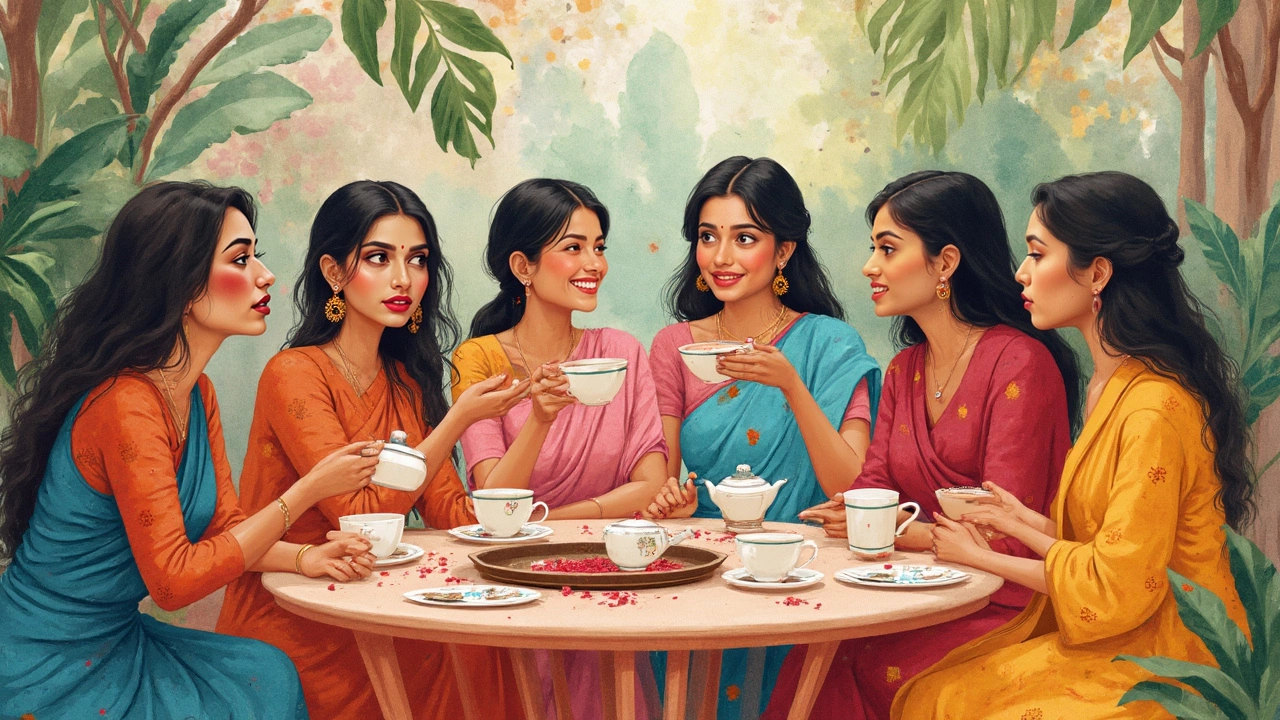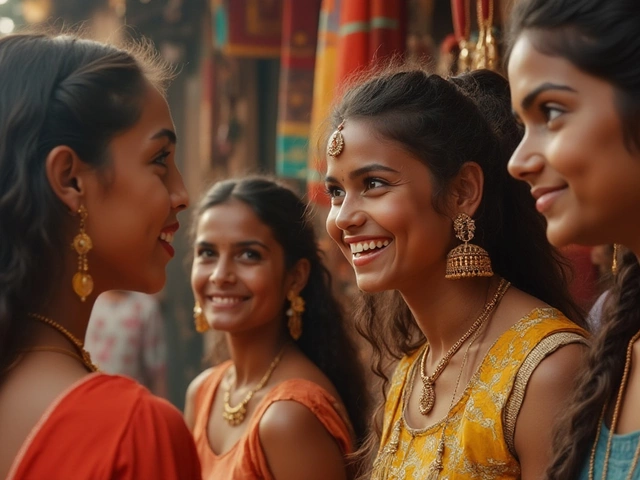Ever wondered if sindoor is just a married woman's affair? Traditionally, it's seen that way, but things are changing. So, what happens when an unmarried girl wants to wear sindoor? Does she break some sacred rule? Not really, and that’s what makes this topic so fascinating.
In India, sindoor is more than just a bright red powder. It’s a symbol, often used to signify marriage. Kind of like wearing a wedding ring in many Western countries. Yet, like most traditions, its interpretation can shift over time and between regions. For instance, for some, it's a sign of marital status, while others see it as a mark of respect, even spirituality.
Nowadays, many young women start wearing sindoor just because they like it or to honor a cultural festival, regardless of marital status. It’s becoming more about personal choice than just ticking a box of social norms. And hey, why shouldn’t it be? After all, how we express our traditions is a personal thing, isn’t it?
- Historical Background of Sindoor
- Cultural Significance and Variations
- Modern Takes and Personal Choices
- Societal Implications and Challenges
- Balancing Tradition with Individuality
Historical Background of Sindoor
Sindoor, that vibrant red mark often seen on the parting of a woman's hair, is a trademark of Indian culture. But have you ever stopped to think where this tradition began? It's not just a modern trend; it's got roots going way back to Vedic times. Yeah, we're talking ages back!
During the ancient days, sindoor was linked with religious practices. Vedic scripts, like the Rigveda, have references to marital customs that involve sindoor, marking it as an age-old practice. Women wore it as a dedication to their husbands, almost like a badge of honor. But hold on, it's not just about marital status.
Back in the day, sindoor was made from natural items like turmeric and lime, which when mixed, turn red. This was not just for beauty; it was believed to have some medicinal qualities too. Imagine that!
Fast forward to the era of various Indian dynasties, the tradition picked up momentum. It wasn't just custom, it was more like a cultural pillar across different regions. Again, it wasn't the same everywhere. In some parts, sindoor was part of daily life, while in others, it was reserved for special occasions. Talk about diversity!
Today, while the use of sindoor continues, the motivation behind wearing it varies more than ever. Some see it as a spiritual symbol, others as a fashion statement. And increasingly, unmarried girls are exploring its use, blending tradition with personal expression.
Cultural Significance and Variations
In India, wearing sindoor is much more than just a simple fashion choice. The vibrant red or orange powder holds deep cultural significance across various communities. For many, it's a sign of love and prosperity, often applied by married women in the parting of their hair. But this isn't where the story ends.
Different regions in India have their own spin on sindoor traditions. In North India, for example, women often apply it during significant religious ceremonies and daily rituals, symbolizing the long life and health of their husband. On the other hand, in parts of South India, sindoor isn't as commonly observed, and cosmetics like bindi are more prevalent.
Across places like Bengal, it's not just an everyday symbol but an essential element used in the festival of Durga Puja. Here, both married and unmarried women embrace sindoor not necessarily to mark marriage but as a celebration of the feminine divine. It's fascinating how the meaning and usage of the same tradition can vary so widely!
Throw into the mix the modern takes, where younger generations are redefining what traditions mean to them. Some might wear sindoor as an expression of cultural pride or style - a nod to their roots without the baggage of old customs. This newfound freedom has sparked conversations and encouraged many to embrace tradition on their terms.
Though some folks might cling to old-school beliefs, others see no harm in an unmarried girl wearing sindoor if it resonates with her identity. These cultural shifts often reflect broader societal changes, portraying how India keeps its rich traditions alive while adapting to new lifestyles.

Modern Takes and Personal Choices
These days, the idea of wearing sindoor isn't as rigid as it used to be. A lot of young women are challenging the old rules, and it's pretty refreshing. Let's face it, traditions aren't written in stone, right?
One big reason for this shift is urbanization. As cities grow, cultures blend, making personal expression through traditional symbols like sindoor more flexible. Women today are choosing to wear it not solely as a sign of marriage but as a personal style statement. Imagine seeing your favorite Bollywood actress, strutting the red carpet, sindoor enhancing her look – that’s powerful, right?
Another factor is the rise of gender equality and feminism in India. Many women are now questioning gender-specific norms and the meanings attached to them. Instead of sindoor being a symbol of a woman's marital status, it's becoming a symbol of identity and individuality. It's about showing pride in one's heritage, not one’s eligibility status.
Surveys have shown that nearly 30% of young unmarried women in metropolitan areas have worn sindoor at some point, either for religious events, cultural showcases, or simply because they felt like it. This indicates a growing trend of using traditional elements in personal and empowering ways.
Sindoor also finds its way into daily wear, much like traditional bangles. Pairing a line of sindoor with one's outfit can elevate daily outfits from ordinary to eye-catching. And it's not just for festivals or weddings—it's about embracing culture whenever the mood strikes.
Traditions can evolve, and seeing the sindoor evolve this way is exciting. It's become more than just a sign of someone else's decision; it’s turning into a declaration of personal agency. Women who choose to wear it, or not, are showing us that cultural identities can be both meaningful and modern.
Societal Implications and Challenges
Wearing sindoor as an unmarried girl can stir quite a few reactions in society. In many parts of India, this red mark on the forehead is seen as something reserved for married women. So, for an unmarried girl to wear it, it's almost like she's breaking an unwritten rule.
The challenges are real, and they largely spring from traditional attitudes. Often, wearing sindoor means passing through a cultural performance where everyone is quick to assume you’re married. This can lead to awkward situations or even judgmental stares.
Dr. Kavita Prakash, a well-known sociologist, points out:
"In modern India, there's a strong tension between following traditions and making personal choices. For young women, wearing sindoor can be an act of personal expression rather than a mere cultural obligation."
What's interesting is that this practice isn't just about conforming to roles. It's also about challenging them. As more unmarried women choose to wear sindoor, it starts changing how society perceives it. Traditions are never static; they adapt as people begin to ask questions.
So, where does this leave us? It's important to remember that societal norms evolve when enough people push against the fringes. While wearing sindoor might raise eyebrows now, it may not always. Fashion evolves, personal choices gain prominence, and slowly but surely, these symbols transform.
Here's a quick breakdown of why societal perceptions are changing:
- More women are making independent decisions about their appearance.
- There's increasing acceptance of breaking gender-specific roles.
- A growing move towards individualistic culture rather than conformist.
Understanding and embracing these changes is crucial if we hope for a more inclusive society where traditions are respected but not enforced.

Balancing Tradition with Individuality
Traditions are like old songs: some people find comfort in their familiar tunes, while others reimagine them with a modern twist. The notion of sindoor is no exception. As society evolves, many feel the pull between sticking to age-old customs and expressing their own styles.
In some Indian families, wearing sindoor is still expected of married women. But in today's more cosmopolitan settings, it's not unusual to see young, unmarried girls donning it during festivals like Durga Puja or while participating in cultural events. This mix of tradition and personal style shows that individuality is carving its space even in deeply rooted practices.
Balancing these aspects might mean having open conversations within the family about what sindoor signifies to different generations. It’s essential to respect each other's views. While some might see wearing sindoor without being married as rebellious, others interpret it as embracing the beauty of the tradition without the social strings attached.
Here's a handy way to balance tradition and individuality:
- Know the cultural roots: Understand what wearing sindoor traditionally means in your family or community.
- Express your take: Share your reasons if you choose to wear it, bringing your perspective into the discussion.
- Respect differing opinions: Family members might have different views. Embrace a philosophy of live and let live.
- Choose occasions: Perhaps wear sindoor during cultural festivities to blend tradition with personal style meaningfully.
Ultimately, traditions like sindoor are evolving. They can be anchors in our identity while also adapting to personal expressions. It's about finding a balance that respects the past but also feels true to who you are today.



